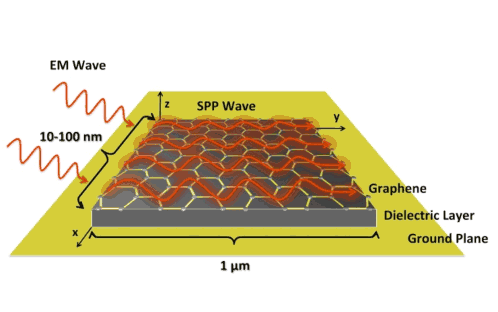Nanobots Could Be Controlled with Graphene Nanoantenna
December 16, 2013
The field of nanotechnology has long been promoted by descriptions of nanorobots and nanomachines that can perform actions at the molecular level, mimicking the actions of cells. Long a darling subject of science fiction authors, nanomachines could conceivably be used in medicine for everything from drug delivery to detecting and destroying clusters of cancer cells. Earlier this year, Chinese researchers announced the development of cell-size robots that could be used in targeted drug delivery.
Now, the road to to truly useful nanoscale technology may have gotten one step shorter with the discovery of another potentially useful property of graphene. Georgia Institute of Technology researchers have conducted computer modeling and simulations that show that the material may make a good antenna at the scale needed to link nanomachines to the outside world.
|
Schematic shows how surface plasmon polariton (SPP) waves would be formed on the surface of tiny antennas fabricated from graphene. The antennas would be about one micron long and 10 to 100 nanometers wide. (Courtesy of Ian Akyildiz and Josep Jornet) |
While a working nanoantenna has yet to be made or demonstrated, "we are exploiting the peculiar propagation of electrons in graphene to make a very small antenna that can radiate at much lower frequencies than classical metallic antennas of the same size," Ian Akyildiz, School of Electrical and Computer Engineering, said in a Georgia Tech release. "We believe that this is just the beginning of a new networking and communications paradigm based on the use of graphene."
Josep Jornet, who worked with Akyildiz on the project and is now assistant professor at the State University of New York at Buffalo, said, "With this antenna, we can cut the frequency by two orders of magnitude and cut the power needs by four orders of magnitude." The nanomachines they envision would include energy-harvesting nanogenerators, and nanoscale sensing, processing and memory components. The nanoscale antenna and transceiver work being done at Georgia Tech would allow the devices to communicate the information they sense and process to the outside world.
Graphene is a one-atom-thick honeycomb lattice of carbon atoms. It is one single molecule, one atom thick, no matter how large it is made, and its unique properties ensure its future usefulness in medtech.
Another team of researchers, at the Baylor College of Medicine (Houston TX) in a paper published on NIH.gov has shown graphene to have possibilities as a direct neuronal interface. But biocompatibility may be an issue. Pinto et al. have published a review of recent work on this topic. Still, another duck is in the row.
About the Author(s)
You May Also Like


.png?width=300&auto=webp&quality=80&disable=upscale)
